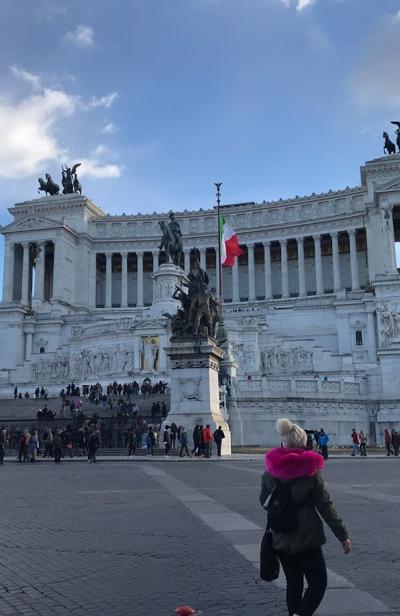Digital Portfolio
The Victor Emmanuel II Monument, also called "The Altar of the Fatherland" or "The Wedding Cake" is a symbol of many things. The monument was built after Victor Emmanuel II death, which was on 1875 A.D. Victor was the first patriotic king of Italy after the war. The monument took 30 years to build it (1885 A.D.-1915 A.D.). The monument was built on the Capitoline Hill, which is the capital of the state. The design of the building shows how it represents Italy. There are 16 columns which represents 16 provinces. There are no religious symbols on the building. This gesture showed how Italy would not be controlled by the Catholic Church governmentally ever again. It is a building to the state, to the military, to the mother state, but not to the church. The building also has a memorial to the unknown soldier at the building entrance. The memorial is for the soldiers that never came back home and are lost in history. Most Italians think of the monument as a giant eyesore in the middle of the hill. They also don't like it because the building process destroyed several medieval architectures and a neighborhood.
jordynlang
12 chapters
15 Apr 2020
Victor Emmanuel II Monument
January 04, 2019
|
Rome, Italy
The Victor Emmanuel II Monument, also called "The Altar of the Fatherland" or "The Wedding Cake" is a symbol of many things. The monument was built after Victor Emmanuel II death, which was on 1875 A.D. Victor was the first patriotic king of Italy after the war. The monument took 30 years to build it (1885 A.D.-1915 A.D.). The monument was built on the Capitoline Hill, which is the capital of the state. The design of the building shows how it represents Italy. There are 16 columns which represents 16 provinces. There are no religious symbols on the building. This gesture showed how Italy would not be controlled by the Catholic Church governmentally ever again. It is a building to the state, to the military, to the mother state, but not to the church. The building also has a memorial to the unknown soldier at the building entrance. The memorial is for the soldiers that never came back home and are lost in history. Most Italians think of the monument as a giant eyesore in the middle of the hill. They also don't like it because the building process destroyed several medieval architectures and a neighborhood.

Share your travel adventures like this!
Create your own travel blog in one step
Share with friends and family to follow your journey
Easy set up, no technical knowledge needed and unlimited storage!